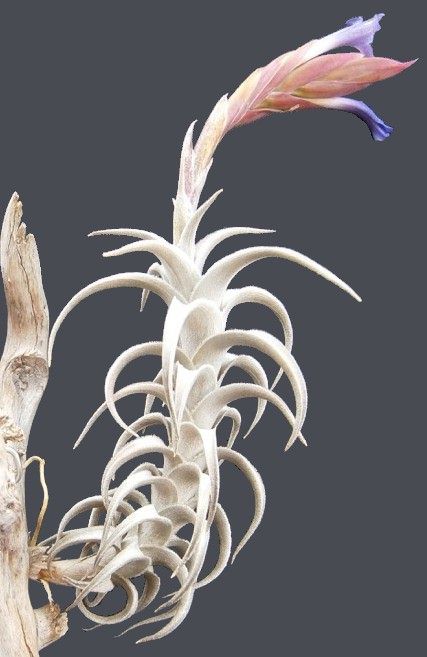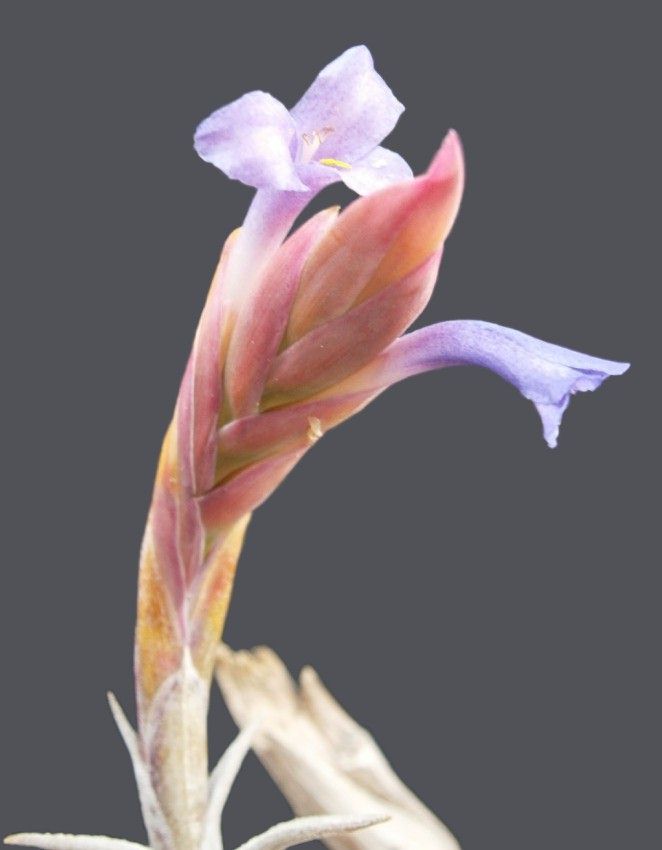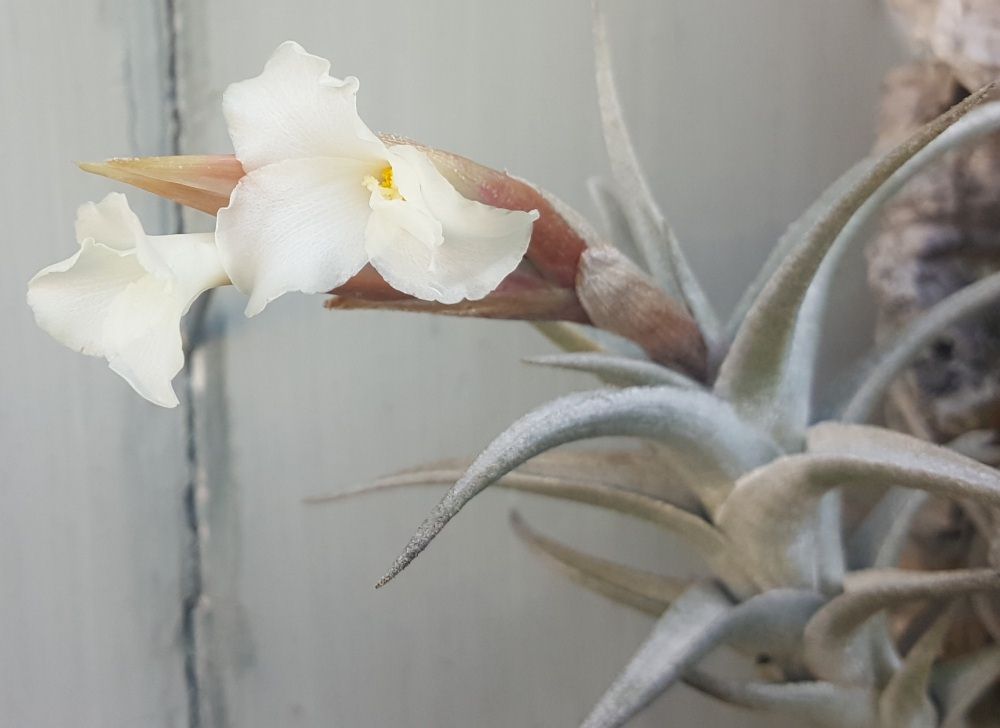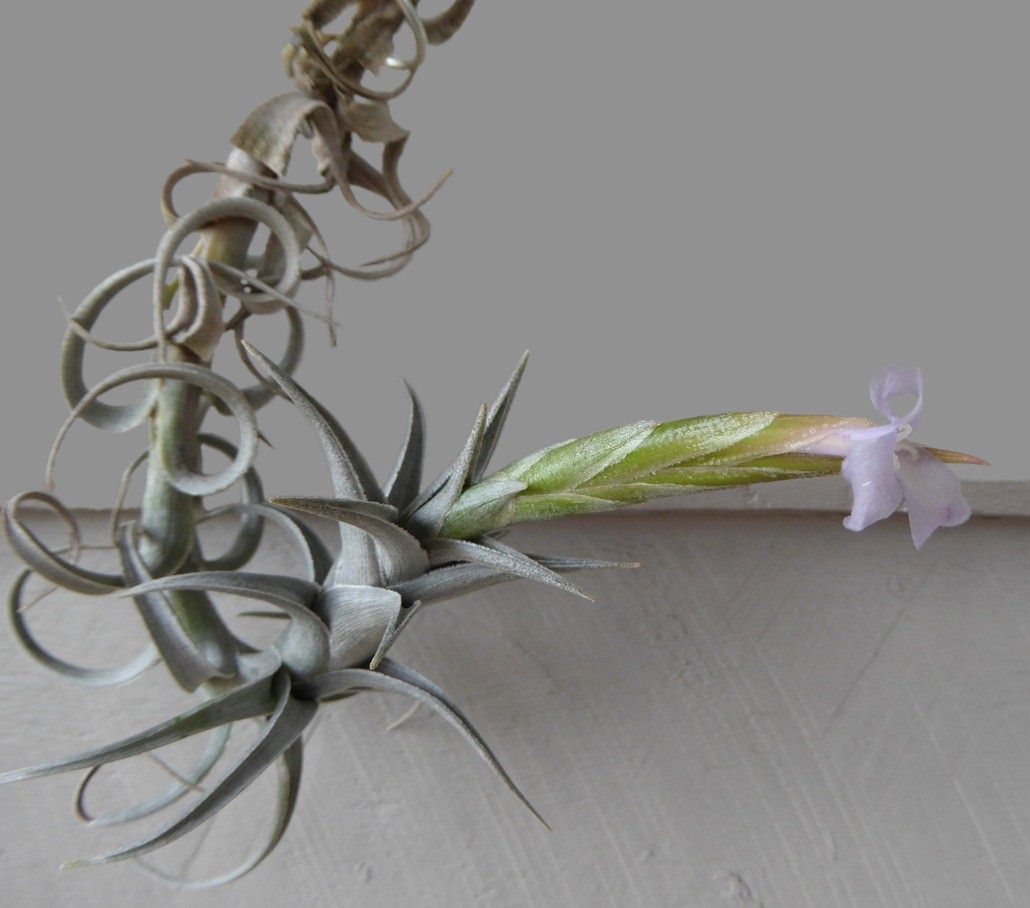



Len Colgan 12/17 ... "Chris, T. yuncharaensis has purple flowers. Is that possibly the plant BOL #5 with white flowers, occasionally speckled with a tiny bit of violet, that I collected near Yunchara? I call it T. aff. yuncharaensis ?"
Bruce Dunstan 01/18 ... "Only one flower on this plant. The pale petals suggest T. aff. yuncharaensis reading on the Till disc."
* Ed. Nov.2018 ... Note: the T. aff. yuncharaensis has now been registered as T. 'Tojo'.
A Tillandsia xiphioides Ker-Gawler et eia varietatibus caule longo, foliis brevioribus recurvatisque, bracteis florigeris rubro suffusis, sepalis sub obtusis et petalis minoribus violaceis differt.
Typus: Bolivia. Dept. Tarija: prope viam ad Yunchara, 12 km ad occidentem pagi Yunchara, 3000 m.s.m., 13. 07. 1982, saxicola, caespitosa, leg. W Till, H. Hromadnik & E. Haugg sub #WT55 (holotypus WU).
Plant distinctly caulescent to 30 cm long, the flowering axis curved upwards and c. 15 cm long.
Leaves spirally arranged, not secund;
Sheaths c. 7x 18 mm, broadly triangular, clasping the stem, glabrous in most parts, brownish, merging into the blades;
Blades to 5 cm long, c. 1 cm wide at base, spreading and recurved, more or less appressed, densely grey-white lepidote, channeled above, nerved when dry, tapering into an acute apex, with sub ciliate scales at margin.
Scape very short, 2-3 cm long, 2 mm in diameter, glabrous, angled when dry, completely concealed by 3-4 lepidote, reddish, broadly acute or acuminate, nerved scape bracts that exceed the scape internodes.
Inflorescence simple, narrowly lanceolate, acute, 5.5-6.5 cm long, c. 8 mm wide, 1-3 (mostly 2)-flowered slightly complanate.
Flowers distichous 37-40 mm long, very fragrant; pedicels stout, c. 2 mm long.
Floral bracts carmine with greenish hyaline margins, ecarinate, smooth, glabrous, acute, in part with very few scales near the apex, 35-42 mm long, 11-12 mm wide, completely concealing the glabrous rachis and sepals.
Sepals ovate-lanceolate, widest below the middle, subobtuse, glabrous, smooth, 23-24 mm long and 6-7 mm wide, equally c. 1 mm connate, the anterior ones ecarinate, the posterior ones very obtusely carinate and subalate only at the apex.
Petals violet, c. 47 mm long, claw c. 30 mm long and 3-3.5 mm wide, blades c. 17 mm long, 7 mm wide, curved spreading with undulate, crisped margins.
Stamens in two series of slightly different lengths, the inner ones exceeding the outer ones by 1 mm; filaments white, flattened, filamentous, straight and not at all plicate, 27.5-28.5 mm long and 1 mm wide at base;
anthers about reaching the throat of the corolla, yellow, subbasifixed, introrse, 5 mm long and 0.5 mm wide.
style with stigma 33 mm long and 0.6-0.7 mm in diameter, slender, slightly surpassing the throat of the corolla, stigma lobes spreading, stigma of the conduplicate (-spiral) type;
Ovary conic-cylindric, 5 mm long and 2 mm in diameter; 1 ovules sessile, caudate, the tail about as long as the ovule;
placenta elongated, as long as the locules.
Tillandsia yuncharaensis is restricted to a small area in southernmost Bolivia where it grows in groups on rocks. It is easily recognized by its long stems, which are covered with dead leaves at the base, and by its violet petals.
Within the T. xiphioides alliance, it occupies very high elevations (3000-3100 m) while typical T. xiphioides is found normally at 600-1100 m in its lower range to 2100-2650 m in its upper range and usually grows as an epiphyte.
It is distinguished from Tillandsia muhrii Rauh by its habit, flower shape, and fragrance. The flowers of T. muhrii are not fragrant. The related T. xiphioides var. tafiensis L.B. Smith has densely pruinose leaves, short stems and pale blue petals.
There may be some affinity with Tillandsia diaguitensis Castellanos and T. muhrae W. Weber, both growing at lower elevations (c. 2000-2350 m) in Jujuy, Argentina, and having white flowers. In T. diaguitensis they are fragrant, in T. muhrae no information concerning fragrance is given in the protologue.